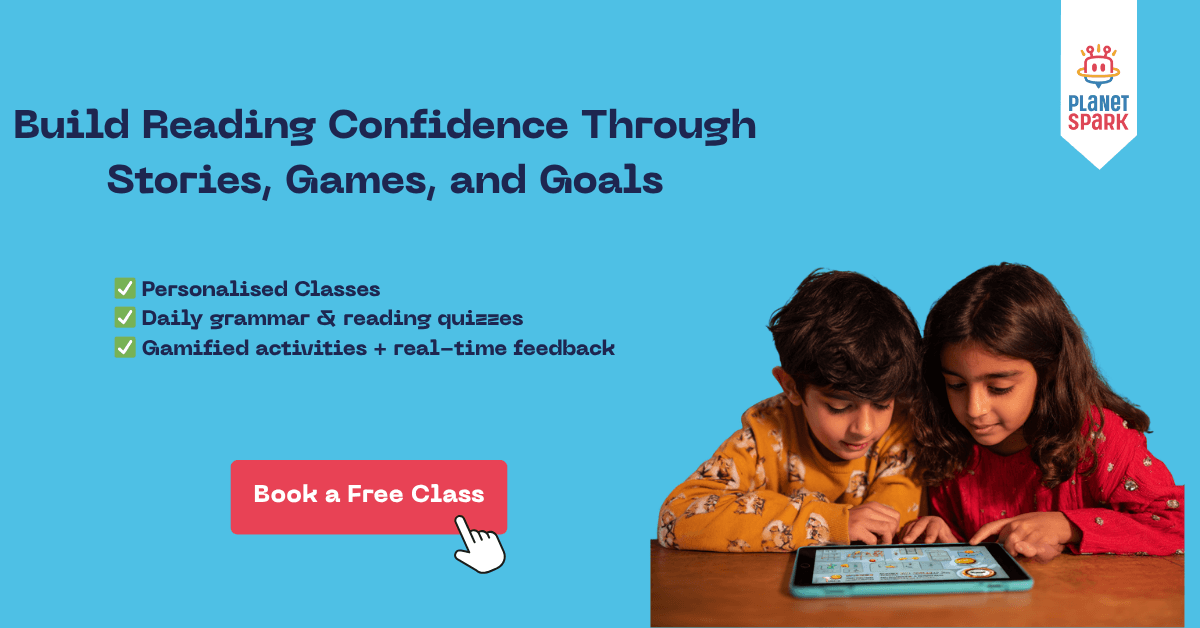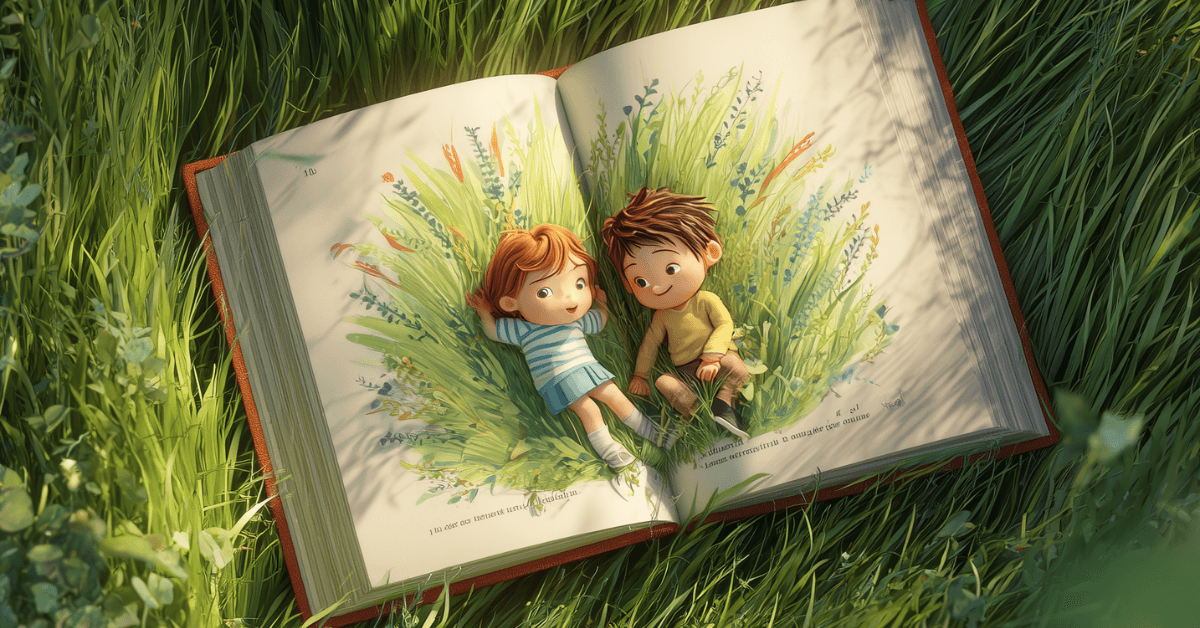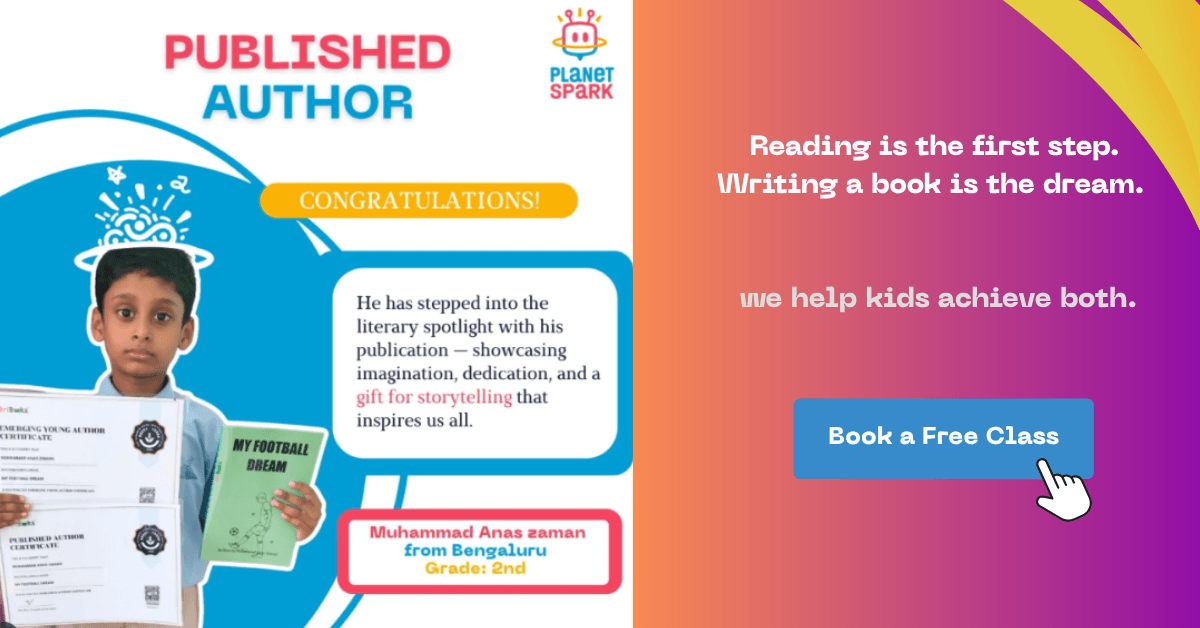How to Develop Reading Habit in Kids: 11 Smart Ways

Reading is not just a subject it’s a skill that powers every area of a child’s life. But in the age of screens and short attention spans, how can parents foster a genuine love for reading?
This blog explores powerful strategies to develop reading habits in kids and explains how PlanetSpark’s Spoken English course complements this journey by enhancing reading, speaking, and comprehension skills together.
How to Develop Reading Habit in Kids: Practical Tips
Developing a reading habit in your children is one of the best gifts you can give to them as parents. Here’s how you can cultivate a strong reading habit in your child through simple yet effective practices.
Start Early with Picture Books and Read-Aloud Sessions
The journey toward developing a love for reading begins long before a child can read independently. Parents should start early by reading aloud to toddlers and preschoolers. Expressive storytelling, with voice modulation and lively narration, brings characters and emotions to life, making storytime enjoyable. Show your child how to hold a book, turn the pages, and follow the text with your finger. Early read-aloud sessions not only introduce children to language rhythm but also form a strong emotional bond with stories.

Create a Reading-Friendly Environment at Home
A child’s environment plays a major role in shaping habits. Create a cozy, inviting space that encourages reading. It could be a small corner with soft lighting, comfortable cushions, and shelves filled with colorful books. Keep a mix of genres such as picture books, adventure stories, comic books, rhymes, and fact-based books to cater to different moods. Make sure the books are easily accessible so your child can pick one up without assistance. Limit distractions like television and phones during reading time so that the focus remains on the story.
Set a Regular Reading Routine
Like any other good habit, reading develops through consistency. Set aside a fixed time every day for reading it could be bedtime stories, an afternoon reading break after homework, or a family reading hour on weekends. Even dedicating just 15 to 20 minutes a day can create a huge difference over time. Always choose a time when your child feels relaxed and receptive rather than tired or distracted. When reading becomes a regular part of the day, it naturally turns into an enjoyable habit.
Be a Reading Role Model
Children imitate what they see, so the best way to inspire them to read is to be a reader yourself. Let your child see you reading books, newspapers, or magazines. Talk to them about what you are reading and share interesting facts or stories. Discuss your favorite books or characters with enthusiasm. By modeling reading behavior, you show them that books are lifelong companions worth cherishing.
Let Them Choose What They Want to Read
One of the most effective ways to spark a genuine interest in reading is to give children the freedom to choose their own books. Let them explore and select whatever catches their eye, even if it’s a comic book or something below their reading level. Avoid forcing them to read only “serious” or “meaningful” books, as this can make reading feel like an obligation. The goal is to help them associate reading with fun and freedom rather than pressure or rules.
Reading is just the first step help your child express what they read with confidence. Explore programs that combine reading with real-world speaking skills.
Give your child the gift of fluent English. Book a free trial today!
Engage With the Story Don’t Just Read
Reading should never be a passive activity. To make it more engaging, turn it into an interactive experience. Ask your child questions like “What do you think will happen next?” or “Why do you think the character did that?” Pause to explain new or difficult words and use expressive tones when reading dialogues. This interactive approach builds comprehension skills, enhances vocabulary, and strengthens the emotional connection between the child and the story.
Here are some secrets of booking reading that must be known to start to inculcate reading habits in a child.
Use Audiobooks and Read-Along Tools
For auditory learners, audiobooks can make reading come alive. Listening to stories helps children understand pronunciation, tone, and expression. You can listen to audiobooks together during long drives or play them at home while your child follows along in their own copy of the book. Read-along tools or audio storybooks are excellent for building listening comprehension and modeling fluent reading.
Gamify the Reading Process

Reading doesn’t have to be a quiet, solitary activity it can be playful and exciting. Turn reading into a game by introducing fun challenges or tracking progress in creative ways. You can make a reading chart at home where each finished book earns a star or sticker. Create weekly reading challenges or have “guess the ending” games after finishing a chapter. Little competitions and achievements make reading more rewarding and keep kids motivated to continue exploring new books.
Let's find out some Fun and Engaging Reading Activities for Kids
Combine Reading with Speaking Practice
Reading and speaking skills go hand in hand. Encourage your child to retell stories in their own words, recite favorite lines, or describe the characters they love most. When children discuss books, they learn to organize their thoughts, express opinions, and communicate clearly skills that go far beyond reading alone.
Connect Books to Real Life
Books are even more powerful when children can relate them to the real world. Help your child make connections between stories and their experiences. For instance, read The Jungle Book before visiting the zoo, or explore books about planets before a science project. Linking stories to real places, people, or events makes reading practical and meaningful.
Celebrate Progress and Effort
Encouragement goes a long way in nurturing a love for reading. Celebrate every small achievement whether it’s finishing a book, learning new words, or trying a new genre. Maintain a reading log or a bookshelf chart to record their journey. You can even organize a small celebration when your child completes a reading milestone, like a “mini book launch” or a “reader of the week” badge. Focus on effort rather than perfection, and make sure your child feels proud of their progress.
Want to Turn Reading Into Real Conversation?
Our storytelling sessions and situational dialogues help kids speak fluently about what they read.
Give your child the confidence to speak with clarity Book a free class now!
Books Reading Examples for Kids (By Age and Interest)

Choosing the right book is as important as encouraging reading. Age-appropriate, interest-aligned, and linguistically accessible books motivate kids to turn the page. Here’s a curated list for Story Reading Books for Kids 3–8 age groups and stages:
For Ages 2–3 (Toddlers and Early Listeners)
Reading books for 2 year olds is all about fun, rhythm, and interaction. At this age, children enjoy bright pictures, short sentences, and playful textures that make storytime exciting. These books introduce basic words and sounds while nurturing curiosity and imagination.
Recommended Books:
Dear Zoo by Rod Campbell
Goodnight, Gorilla by Peggy Rathmann
The Very Busy Spider by Eric Carle
Spot Goes to the Farm by Eric Hill
Reading Tip: When exploring reading books for 2 year olds, keep sessions short and lively. Point to pictures, mimic animal sounds, and encourage your child to repeat simple words. This builds vocabulary, focus, and an early love for reading.
For Ages 4–5 (Early Language Learners)
These books use rhyming, repetition, and vivid visuals to build pre-reading and vocabulary skills:
Brown Bear, Brown Bear, What Do You See? by Bill Martin Jr.
The Very Hungry Caterpillar by Eric Carle
Goodnight Moon by Margaret Wise Brown
Peppa Pig First Readers (Series)
Reading Tip: Use expressive voice modulation, sound effects, and finger tracking to build phonemic awareness.
For Ages 6–8 (Emerging Readers)
These books have simple storylines and are great for self-reading:
Frog and Toad Are Friends by Arnold Lobel
Magic Tree House series by Mary Pope Osborne
Amelia Bedelia by Peggy Parish
Dr. Seuss Collection
Reading Tip: Introduce reading aloud alternately one page by the child, one by you.
For Ages 9–12 (Confident Readers)
At this stage, children enjoy plot twists, character growth, and imaginative worlds:
Harry Potter and the Philosopher’s Stone by J.K. Rowling
Charlotte's Web by E.B. White
The Chronicles of Narnia by C.S. Lewis
Diary of a Wimpy Kid series by Jeff Kinney
Reading Tip: Discuss the moral of the story, character flaws, or key decisions with your child.
Don’t Let Reading Stop at Silent Pages
When kids talk about what they read, they remember more, speak better, and grow smarter.
Good Reading Habits for Students
Building strong reading habits early helps students develop focus, creativity, and comprehension skills that last a lifetime. When thinking about how to develop reading habit in students, consistency and genuine interest matter more than the number of pages they read. Reading should be seen as an enjoyable journey, not an academic task.
To cultivate good reading habits in students, start with a few simple practices:
Read Every Day: Encourage students to set aside 15–20 minutes daily for reading. Regular practice strengthens language and thinking skills.
Choose Books of Interest: Let students pick topics they love from mystery stories to science or history so they stay motivated.
Set Reading Goals: Small goals like finishing a book each week or writing a short summary build discipline and confidence.
Discuss and Reflect: Encourage group discussions or parent child talks about what they read to deepen understanding.
Create a Reading Space: A quiet, distraction-free corner with comfortable seating makes reading time enjoyable.
Parents and teachers play a key role in developing reading habit in students. Appreciating their effort, celebrating milestones, and guiding them toward diverse genres can make reading a natural part of their daily routine. With the right support, students not only improve academically but also discover the joy of reading beyond textbooks.
Why Is Reading Habit Important for Kids?
Reading nurtures more than literacy. It builds:
Vocabulary and language fluency
Concentration and cognitive development
Imagination and empathy
Communication and critical thinking skills
Understanding the importance of reading books from an early age helps children develop lifelong skills those who read regularly tend to perform better academically, show higher emotional intelligence, and grow into articulate, confident individuals.

Types of Reading Skills
Reading isn’t one skill it’s a combination of decoding, comprehension, fluency, and vocabulary building. Here’s how each skill works and how to boost it:
Decoding/ Word Recognition: This is the child’s ability to sound out words and recognize them by sight.
Reading Fluency: Fluency is about reading smoothly, with appropriate speed, accuracy, and expression.
Reading Comprehension: This is the ability to understand, interpret, and respond to what’s read.
Vocabulary Development: This involves learning new words, their usage, and their context in reading.
Critical Thinking Through Reading: This skill involves making predictions, comparing characters, or evaluating decisions made by protagonists.
Find here the detailed guide for Reading Skills for Children: Types and Ways to Improve.
How PlanetSpark Builds Reading and Speaking Confidence Together
PlanetSpark’s Spoken English course isn’t just about grammar or vocabulary. It’s a skill-building program that transforms passive readers into fluent speakers and expressive thinkers.
Here’s how:
Live, Interactive English Conversations Daily: Children engage in daily spoken dialogues based on real-life situations from classroom scenes to travel talk promoting contextual understanding of what they read.
Accent Neutralization & Articulation: Reading fluency is tied to clear pronunciation. We reduce MTI and improve phonetics using expert-designed modules.
Vocabulary Enhancement: Our Lexical Resource Enhancement model teaches vocabulary in context, through phrases, collocations, and usage just like in the books they read.
Role Plays & Situational Dialogues: Children act out characters, play book-based games, and conduct reader's theater which boosts both reading fluency and speaking confidence.
Instant AI Feedback & Fluency Reports: Kids receive real-time feedback on their reading aloud or storytelling performance, helping them improve clarity and flow.
Conclusion
Reading is not a one-day activity it’s a lifelong journey. And that journey begins at home, with conscious effort, encouragement, and the right resources.
By combining strong reading habits with guided spoken English practice at PlanetSpark, you help your child not just understand English, but own it with confidence.
More interesting blogs:
Frequently Asked Questions
To help your child improve their reading, start by creating a daily reading routine and offering age-appropriate books. Read aloud together and discuss stories to make the experience interactive and fun — this helps develop a reading habit in your child naturally.
The 3 finger rule helps kids choose the right book. If a child finds three or more unfamiliar words on one page, the book may be too hard. This simple trick makes reading enjoyable and supports the reading habit for kids.
Encourage students to read regularly by setting goals, offering engaging books, and creating a calm reading space. Teachers and parents play a key role in showing how to develop reading habit in students through motivation and example.
At least 20–30 minutes of reading daily is recommended. This can be broken into bedtime stories, school assignments, or independent reading.
For toddlers and preschoolers, picture books, board books, and rhyme-based stories work best. As children grow, move on to early readers, chapter books, and age-appropriate fiction or nonfiction based on their interests.
Try different genres, formats, or interactive approaches. Audiobooks, read-aloud sessions, book-based games, and letting the child choose their own books can significantly increase interest and engagement.
You can start reading to your child as early as infancy. Even newborns benefit from hearing the rhythm of language and seeing colorful images. The earlier you start, the more naturally reading becomes a part of their daily routine.
Personalized Communication Report
Record a video to get a AI generated personalized communication report for your child

Hi There, want to try these
tips for your child with
LIVE with our expert coach?
Let's check your child's
English fluency
